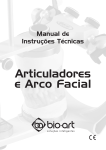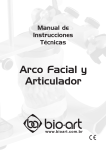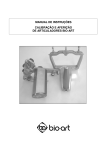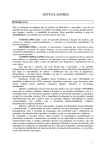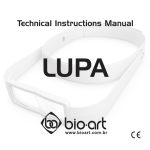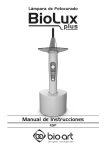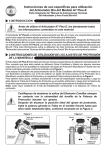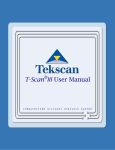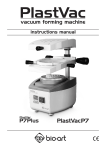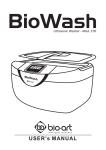Download FACE-BOW AND ARTICULATOR - Bio-Art
Transcript
Technical Instructions Manual FACE-BOW AND ARTICULATOR www.bioart.com.br NOTE: All rights reserved. No part of this publication may be reproduced, stored in a retrieval system, or transmitted, in any form or by any electronic, mechanical, photocopyng, recording or other means, without the prior writen consent of Bio-Art Equipamentos Odontológicos Ltda. Authorised Representative in the European Community: Obelis s.a Boulevard Général Wahis 53 1030 Brussels, BELGIUM Tel: +(32) 2. 732.59.54 Fax: +(32) 2.732.60.03 E-Mail : [email protected] CONTENTS 01 - Introduction . . . . . . . . . . . . . . . . . . . . . . . . . . . . . . . . . . . . . . . . . . . . . . . . . . . . . 01 02 - Standard Face-Bow registration procedure . . . . . . . . . . . . . . . . . . . . . . . . . . . . . 02 2.1 - Dentate and partially dentate patients . . . . . . . . . . . . . . . . . . . . . . . . . . . . . 02 2.2 - Totally edentureless patient . . . . . . . . . . . . . . . . . . . . . . . . . . . . . . . . . . . . . 04 03 - Mounting the casts on the Articulator. . . . . . . . . . . . . . . . . . . . . . . . . . . . . . . . . . 05 3.1 - Preparing the Articulator . . . . . . . . . . . . . . . . . . . . . . . . . . . . . . . . . . . . . . . 05 3.1.1 - Articulator Model 4000-S . . . . . . . . . . . . . . . . . . . . . . . . . . . . . . . . . . . . . 05 3.1.2 - Articulator Model A7 Plus . . . . . . . . . . . . . . . . . . . . . . . . . . . . . . . . . . . . . 06 3.1.3 - Articulator Model A7 Fix . . . . . . . . . . . . . . . . . . . . . . . . . . . . . . . . . . . . . . 06 3.2 - Mounting the upper cast . . . . . . . . . . . . . . . . . . . . . . . . . . . . . . . . . . . . . . . 07 3.2.1 - Standard Face-Bow . . . . . . . . . . . . . . . . . . . . . . . . . . . . . . . . . . . . . . . . . 07 3.3 - Interocclusal Registration . . . . . . . . . . . . . . . . . . . . . . . . . . . . . . . . . . . . . . 08 3.4 - Mounting the Mandibular Cast. . . . . . . . . . . . . . . . . . . . . . . . . . . . . . . . . . . 08 3.5 - Particularities of the Rail Mounting Plate. . . . . . . . . . . . . . . . . . . . . . . . . . . 09 04 - Special features of the Bio-Art Articulators . . . . . . . . . . . . . . . . . . . . . . . . . . . . . 10 05 - Special features of the Standard Face-Bow. . . . . . . . . . . . . . . . . . . . . . . . . . . . . 11 06 - Accessories . . . . . . . . . . . . . . . . . . . . . . . . . . . . . . . . . . . . . . . . . . . . . . . . . . . . . 11 07 - Safety Rules . . . . . . . . . . . . . . . . . . . . . . . . . . . . . . . . . . . . . . . . . . . . . . . . . . . . 12 08 - Technical Service . . . . . . . . . . . . . . . . . . . . . . . . . . . . . . . . . . . . . . . . . . . . . . . . 12 09 - Guarantee . . . . . . . . . . . . . . . . . . . . . . . . . . . . . . . . . . . . . . . . . . . . . . . . . . . . . . 13 10 - Part List Articulator 4000-S . . . . . . . . . . . . . . . . . . . . . . . . . . . . . . . . . . . . . . . . . 14 11 - Part List Articulator A7 Plus . . . . . . . . . . . . . . . . . . . . . . . . . . . . . . . . . . . . . . . . . 15 12 - Part List Articulator A7 Fix . . . . . . . . . . . . . . . . . . . . . . . . . . . . . . . . . . . . . . . . . . 16 13 - Part List Standard Face-Bow. . . . . . . . . . . . . . . . . . . . . . . . . . . . . . . . . . . . . . . . 17 1 - INTRODUCTION IMPORTANT NOTE: Before using your BIO-ART articulator, please read carefully all the Instructions Manual. The articulator is an instrument used to simulate the maxillo-mandibular relation and movements of a patient in a laboratory, with the purpose of studying the occlusion and production of dental devices that will be used by the patient. These devices include complete dentures, partial dentures, bridges, crowns and bite plate, among others. The face-bow is an instrument used to register the position of the patient's dental arcade in relation to the skull and transfer this record to the articulator. The BIO-ART semi-adjustable articulators are Arcon type conventional equipment (models 4000-S, A7 Plus and A7 Fix) and Non-Arcon type model EVA. Therefore, the mounting technical procedures are the same for these articulators. This Manual contains only basic and simplified information regarding the use of the equipment, which do not replace the need of a specific course of Occlusion and/or Prosthesis, offered in many Teaching Institutions and Dental Faculties, as a compulsory discipline. IMPORTANT NOTE: The use of the equipment by professionals not qualified can cause damage or harm to the product and/or patient. The articulator and face-bow’s use are restricted to qualified professionals. It is important to emphasize, however, that the semi-adjustable articulator and face-bow provide a simple, fast and highly precise way of reproducing the human mandible movements, enabling the dental professional to carry out corrective and restorative dentistry tasks more easily, rapidly and at lower costs than those of traditional, time-consuming techniques involving expensive and highly complex equipment. Furthermore, the semi-adjustable articulator and face-bow produce far more accurate results than those produced by “simple hinge” articulators, which involve arbitrary mounting of the mandibular cast on the device and whose movements are also limited. The use of the semi-adjustable articulator and face-bow is therefore recommended for most prosthetic, occlusal and rehabilitation work. The technique is simple, fast and easy, offering highly satisfactory results for both the patient and professional. 1 2 - STANDARD FACE-BOW REGISTRATION PROCEDURE 2.1 - DENTATE AND PARTIALLY DENTATE PATIENTS a) By using bite registration material (“godiva”, wax, among others) three points on the fork are made: one frontal point, in the exact centre of the fork, and two points at the back, one at each semi-arch of the fork (fig.1). FIG. 1 FIG. 2 FIG. 3 b) Position the bite fork so that the midline of the fork handle is aligned with the midline of the maxilla and place it on the upper teeth, holding it firmly in place until the registration material hardens (fig. 2). Only a small amount of registration material should be used since the purpose is to record only the cusp tips of the teeth while keeping the fork as immobile as possible (fig. 3). Afterwards it is advisable to try the cast on the registration to check its stability (absence of clearance) (fig. 4). Note: Alternatively, a pre-impression of the teeth can be made on the upper model and then refined in the mouth. In the case of patients who have partially jagged teeth, it is important to locate points that hold the fork stably in place, despite the missing teeth and the points used for the transfer. c) Recline the patient in the chair to reduce the induction of tensions on the fork set and face-bow asking him to keep the fork in the same position, supporting the thumbs against the maxilla (fig. 5). Take the face-bow to the patient and introduce the fork fixation assembly into the bite fork handle, assuring that the wing nut is upside down (fig. 6). Then carefully insert the face-bow earpieces into the patient's external auditory meatus as if you were putting a stethoscope into his ears (fig. 7). FIG. 4 FIG. 5 FIG. 6 2 FIG. 7 FIG. 8 FIG. 9 FIG. 10 FIG. 11 FIG. 12 d) Place the nasion relator on the face-bow cross bar, when using the face-bow Standard. For both models, centre the nosepiece on the patient's nasion. Attention to the correct position of the nazium relator as indicated in picture 7.5b. The earpieces should now be carefully positioned as deeply as possible in the patient's auditory meatus and the nosepiece should be gently pressed against the patient's nasion while tightening the wing nuts of the nazion relator assembly (fig. 8). Afterwards, tighten the three screws of the Standard face-bow (fig. 9 and 14). Wrong Position (fig. 7.5a) Correct Position (fig. 7.5b) e) With the nazion relator and the face-bow tightened and the patient holding the fork immobile, push the fork fixation assembly forward, sliding it on the fork handle until it is as close as possible to the lips, without touching them, in order to achieve increased stability. Then tighten the wing nuts of the fork: first the double articulated nut (connection block) (fig. 3) and then the horizontal slide bar nut, so that the fork is supported at one end of its handle, resulting in less tension on it (fig. 10 and 11). To ensure proper registration, ask the patient to remove his thumbs from the bite fork and check if the fork and the face-bow are stable and immobilized (fig. 12). f) When using the articulator model 4000-S, record the approximate intercondylar distance, whose reading is taken on the front edge of the face-bow Standard. The three numbers (1, 2 and 3), separated by a reference mark, correspond to the intercondylar distances: small, medium and large. When the reference mark is aligned with the distance indicator, always use the smallest distance for the patient. This information should be registered in the patient´s records for subsequent adjustment of the articulator. Note: In other articulator models, the intercondylar distance is fixed at an average of 110mm and the intercondylar distance is not adjustable. In this case, disregard the abovedescribed registration of the face-bow. 3 g) Loosen the wing nut of the nosepiece and remove the nazion relator assembly from the face-bow. Then, loosen the central wing nut of the face-bow and hold the cross bar of the bow at the same time the patient opens the mouth slowly, removing the whole set carefully (fig. 15, 16 and 17) FIG. 15 FIG. 16 FIG. 17 2.2 - TOTALLY EDENTURELESS PATIENT a) When registering totally edentureless patients with the face-bow, use the special edentureless fork, or Conti fork (optional), to maintain the prove plate and roller wax. b) After the patient's registration on the wax roller, heat both handles of the fork slightly in a flame and press them on the upper wax roller, which was previously joined to the lower wax roller, or not, with the midline of the fork handle aligned with the midline of the patient (fig. 18, 19). c) Place the set (fork + wax rollers) in the patient's mouth inserting it on the alveolar edges (fig. 20) Note: When carrying out the registration with wax rollers which were previously joined, ask the patient to keep it in position and close his mouth. d) Repeat steps (c) to (g) of item 2.1 FIG. 18 FIG. 19 4 FIG. 20 3 - MOUNTING THE CASTS ON THE ARTICULATOR 3.1 PREPARING THE ARTICULATOR The adjustments of the articulators mentioned below are only used to mount the casts on the articulator. However, the professional may choose to use other angulation techniques to personalize the settings. FIG. 21 The marks 1, 2 and 3 of the Face Bows are used to adjust the intercondylar distance (small, medium, large), when the mounting is carried out with the Articulator Model 4000-S. For the other articulators models, it must be ignored. 3.1.1 Articulator Model 4000-S FIG. 22 FIG. 23 FIG. 24 a) Fix the condylar elements into the lower frame holes according to the patient's registration (1, 2 and 3) made with the face-bow. With the help of the condylar element shaft, tighten the condylar elements slightly (fig. 21). b) Adjust the same intercondylar distance in the upper frame, expanding or closing the condylar guide with the micrometric expanding spindle (fig. 22). Note: To facilitate adjustment of the intercondylar distance of the upper frame using the micrometric spindle, leave the wing screw of the condylar guide inclination slightly loose. The relationship between the intercondylar distance and the positioning of the condylar guide is given as follows: *Small = without expansion (condylar guide totally closed) *Medium = first marking on the condylar guide axle *Large = second marking on the condylar guide axle Important: A fine adjustment should be made to prevent lateral movements of the upper frame in relation to the lower frame observing that the position of the condylar elements should be touching the posterior and superior walls of the condylar guide and the lateral of the bennet angle adjusting device simultaneously (fig. 23) i.e., the reference mark for the adjustment of the intercondylar distance in the condylar guide axle does not always coincide with the correct position of adjustment of the upper frame. A fine adjustment is therefore necessary, using the expanding spindle. c) Adjust the condylar guide at a 30° angle and a negative “Benett” angle (fig. 24 and 25), assuring the stability of the articulator at a central position. FIG. 25 5 3.1.2 - Articulator Model A7 Plus To facilitate the mounting of the casts, adjust the Condylar Guides angles at 30º and the Bennet at 0º (fig. 29 and 30). Then push back the upper part of the central lock until feel the “click” (locked position fig. 31). PS.: In order to make sure that the Articulator A7 Plus is totally locked at the centric position, check if the 2 locks (left and right) are at the locked position. FIG. 29 FIG. 30 FIG. 31 3.1.3 - Articulator Model A7 Fix Aiming as main characteristic simplicity and easiness to work, the A7 Fix Articulator was developed with the Bennet and Condyle angles fixed at the average of 15° and 30°, respectively. The intercondilar distance was also fixed at the average of 110 mm. Therefore, this model does not require preliminary adjustments for these components, such as the other models previously mentioned. In order to lock the Articulator A7 Fix in the centric position, there is an innovative system with two lateral pins, denominated: “centric lock pin”. This pin has 3 main positions: first position - totally closed (locks the articulator in the centric position - picture 32); second position - intermediate (releases the articulation movements - picture 33) and third position (allows to remove the upper from the lower frame - picture 34). FIG. 32 FIG. 33 6 FIG. 34 3.2 - MOUNTING THE UPPER CAST 3.2.1 Standard face-bow The Standard face-bow should only be used with the articulator model 2000, 4000-S and 5000. It should not be used with the EVA Fix and EVA Plus models. a) Fix the face-bow Standard to the upper frame of the articulator by fitting the earpiece holes on the small pins located on the external edge of the condylar guide (fig. 39). FIG. 39 FIG. 40 b) Support the front part of the Articulator Upper Frame on the cross bar of the face-bow. Close the face-bow firmly by fastening the central face-bow wing nut and placing the whole face-bow together with the upper frame on the lower frame of the articulator (fig. 40,41 and 42). c) Place the upper cast, with retentions and previously hydrated, on the fork registration. Lift the Upper Frame of the articulator, depositing a small amount of plaster on the Upper Mounting Plate and a portion on the top of the Upper Cast. Then, using one of your hands, keep the fork and the cast in position, avoiding any movement of the Bite Fork and carefully hinge the Upper Frame until it touches the cross bar of the face-bow. Wait for the plaster to harden (fig. 43). Note: The sides of the mounting plates, which are in contact with the articulator frames, should be devoid of plaster. Important: In order to achieve greater stability and precision during the transfer procedure, it is advisable to use the Fork Support (optional) and plaster type IV (fig. 44). d) Remove the face-bow from the articulator. FIG. 41 Fork support (optional) FIG. 42 Fork support (optional) FIG. 43 7 FIG. 44 3.3 - INTEROCCLUSAL REGISTRATION Wax registration To set up the mandibular (lower) cast in the articulator, you should have a record correlating the upper and lower dental arches, according to the purpose of the mounting, in one of the following ways: Maximum Intercuspation (MI); Centric Relation (CR); FIG. 54 These records can be made using material of the operator's preference: wax, resins, addition or condensation silicon, etc. (fig. 54 and 55) Silicon registration FIG. 55 To obtain the M.I registration, place the selected material to register the patient's arcade and ask him to occlude. There are several techniques to obtain the R.C registration, i.e. Peter Dawson's technique (bilateral manipulation of the mandible), Lucia's JIG technique and James Long (use of plastic spacer) among others. Note: For totally edentureless patients, this registration is made when the upper and lower wax rollers are joined based on the correct dimensions of the patient. 3.4 - MOUNTING THE MANDIBULAR CAST FIG. 56 FIG. 57 a) Place the Incisal Guide Pin in the Upper Frame of the articulator with its rounded tip pointing downward so that the upper and lower frames are parallel, i.e. on the zero marking of the Incisal Guide Pin (fig. 56) b) Now turn the articulator upside down on the laboratory bench and affirm the lower cast, with retentions and previously hydrated, upon the interocclusal register that should be placed in the mounted upper cast (fig. 57). In totally edentureless patients, this was obtained by joining the wax rollers together. c) We recommend fixing the casts with rubber bands or staples (fixed with “godiva” or wax) so that they remain in position until the plaster hardens. Place a small amount of plaster on the lower part of the mandibular cast and a small amount on the mounting plate of the lower frame of the articulator to fill in the gap between them (fig. 58). FIG. 58 8 FIG. 59 TROCAR A FOTO d) Make sure the condylar elements are duly positioned and close the lower frame until the Incisal guide pin touches the Incisal table. Afterwards, fasten the articulator frames using rubber bands to prevent possible distortion occurred by the plaster expansion (fig. 59) Note: The sides of the mounting plates, which are in contact with the articulator frames, should be devoid of plaster. e) After the plaster hardens, turn the articulator back to its upright position (lower frame resting on the laboratory bench) and complete the work, filling the cast fixation towers with plaster for the finishing touches (fig. 60). FIG. 60 FIG. 61 FIG. 62 FIG. 63 3.5 PARTICULARITIES OF THE RAIL MOUNTING PLATE The Rail Mounting Plate was specially developed to allow the removal of the plaster cast without the needs of breaking it, as occurs in most of the conventional mounting plates. In order to use of this resource satisfactorily, the professional should take some cares, mainly during the confection of the cast, and afterwards when handling the removal of the plate, occording to the following procedure: a) The plaster finishing on the edge of the mounting plate should be done in such way to avoid excess of plaster around the edge and to allow the splitting and the sliding of the plate afterwards, i.e., during the removal procedure (fig. 61). b) Before the removal of the cast, the plaster contained in the retention hole should be removed with an instrumental tip. The function of this retention hole is to avoid displacement of the plate when handling the cast (fig. 62). c) Once the plaster contained in the retention hole is removed, the cast should be firmly held and a slight strike must be applied on the edge of the plate, in the direction of the arrows stamped in the plate lower face. This procedure will detach the mounting plate from the cast and enable its removal through the sliding (fig. 63). PS: Once the cast is removed from the rail mounting plate, we do not assure its returning to the initial precision since it dependes on the technique applied and quality of the materials used in the process (specially the plaster). 9 10 Mod. 4000-S Stabilization System ** Elastic Band (O´ring) Magnetic Yes Mod. A7Fix Silicone Connection Yes Fixed at 110 mm Fixed at 110 mm Adjustable * Intercondylar Distance No Adjustable Fixed at 15° Adjustable Bennet Angle Central Lock Adjustable / Curve Curve Fixed at 30° Adjustable / Curve Condylar Guide A7 Plus Arcon A7 Fix Arcon Arcon 4000-S Classification Features Model Mod. A7Plus Bio-Art's interchangeable articulators are standardized (calibrated) by the manufacturer to allow for interchangeability of the casts among these articulator models. Only model 4000-S cannot be supplied in the standardized option. Interchangeable Articulators (Optional) Adjustment made through the micrometrical expanding spindle. (Bio-Art's exclusive system) ** Joining system between the upper and lower frames provides stability during articulating movements. * 4 - SPECIAL FEATURES OF THE BIO-ART ARTICULATORS 5 - SPECIAL FEATURES OF THE STANDARD FACE-BOW 5.1 - STANDARD FACE-BOW The Bio-Art Standard model is simple and easy to work with. It has manually tightened wing nuts to fix the fork, eliminating the inconvenient use of the key. In this model, the registration of the position of the patient's upper dental arcade in relation to the skull is transferred to the articulator by setting the complete face-bow in the upper frame assembly of the articulator (chapter 3 Item 3.2.1) The Standard Face Bow can be used with the all Articulators models, its use is forbidden with the Models EVA Fix and EVA Plus. 5.3 - INSTRUCTIONS FOR USE THE NOSE PIECE SUPPORT Slide the Nose Piece Support in the Face-Bow's Cross Bar through the groove, pressing it until realize a slight "click" indicating that the support is fully embedded. The support may be laterally moved, so that it can be placed in the position desired by the operator (fig. 64). FIG. 64 To withdraw the Nose Piece Support, make a movement of twist to facilitate its removal (fig. 65). FIG. 65 6 - ACCESSORIES Fork Support Fox Ruler Camper’s Table Magnetic Mounting Plate Broadrick Flag Metallic Mounting Plate Toothless Fork (Adjustable) 11 Rail Mounting Plate Adjustable Incisal Table (Metallic) Adjustable Platform Case 7 - SAFETY RULES • This manual only contains basic and simplified information regarding the use of the instrument and under no circumstances it is a substitute for a proper training course. The articulator and face-bow are products aimed at the exclusive use of qualified dental professionals. • The Bio-Art face-bow is designed for use with Bio-Art's own articulator and vice-versa. Although, the Standard face-bow is compatible with other articulator models, its use with similar models should be consulted. • Bio-Art articulators are not interchangeable, i.e. the casts mounted on one articulator model should not be transferred (mounted) to any other articulator. Therefore, Bio-Art does not guarantee precision when casts mounted on one articulator are transferred to another. • The only Bio-Art articulators, which are interchangeable, are those which are calibrated in the factory. Thus, for safe and precise interchangeability, casts should be transferred only between calibrated articulators. • Before using the articulator and face-bow, the professional should check the instrument for possible damage, distortion of the incisal pin, face-bow's parallelism, proper centricity of the incisal pin in relation to the lower frame, etc. Should any abnormality be found, Bio-Art's Technical assistance or Authorized Representative should be contacted immediately. • The face-bow should be cleaned with warm water prior to its use. The Bite Fork must be autoclaved and the Earpieces disinfected with a bactericide or with 70° alcohol. • Bio-Art recommends only warm water for the general cleaning of the articulator and facebow. • When using “godiva” or any other registration material, special care should be taken to avoid excessive heating of the material, which might burn the patient's mouth. Bio-Art urges the user to carefully follow the instructions of the registration material manufacturer. • Because the articulator is a precision instrument, it should be handled, transported and stored carefully. Bio-Art provides a plastic case (optional accessory) exclusively designed to accommodate the articulator and to facilitate its transportation. 8 - TECHNICAL SERVICE For your safety, the technical service of this product should be made by people/companies authorized by BIO-ART. Please contact us or the distributors, where the product was acquired. Our web site is: www.bioart.com.br 12 9 - GUARANTEE Bio-Art Equipamentos Odontológicos Ltda., grants 1 year warranty, starting from the date of the device purchase (invoice). The warranty is carried out exclusively by the authorized distributor and includes any manufacturing defect, being provided through the repairing of the product and subjected to the following requirements: • That the product has been used correctly in accordance with the instructions described in the user manual; • The claim is followed by the invoice and registered within the warranty period, accompanying a report with description of the damage and product serial number; • The product is handled, transported and stored with care; • The costs of transport (from and to) is paid by the customer; Warranty limitations: • Natural wears and tear of parts; • Misuse, falls or accidents; • Inadequate transportation; • Repair by unauthorized person; • Use in disagreement with the features and purposes of the device; • Wear from exposure to adverse conditions (humidity, cold and heat); • Damage from lack of cleaning or maintenance with inappropriate products. In case of doubt, contact the manufacturer: BIO-ART EQUIPAMENTOS ODONTOLÓGICOS LTDA. Rua Teotônio Vilela, 120 - Jardim Tangará CEP 13568-000 - São Carlos - SP - Brasil Tel. +55 (16) 3371-6502 - Fax +55 (16) 3372-5953 website: www.bioart.com.br - E-mail: [email protected] CNPJ 58.538.372/0001-56 - I.E. 637.034.447.113 13 14 UN UN UN UN 30 31 UN 21 29 PC 20 28 UN 19 UN UN 18 27 UN 17 UN UN 16 26 UN 15 UN UN 14 UN UN 13 25 UN 12 24 PC 11 UN UM 10 UN UM 09 22 UM 08 23 UM 07 04 UM UM 03 UM UM 02 05 PC 01 06 Unit UM Item 10 - PART LIST - ARTICULATOR 4000-S 2 1 1 1 1 1 4 1 1 1 1 1 1 1 2 2 1 1 1 2 1 1 2 1 2 4 2 4 2 2 1 Qtd. FPIN0744 SCRE0082 SCRE0078 FHST0058 CMES1537 FPIN0053 SPLA0079 FRAM0056 SCRE0011 SALH0074 FCDL1067 FPOS0758 FBCH0060 SCRE0010 FFIX0057 SCRE0008 FRLD0061 FFUS0042 FBCH0059 SCRE0099 FPOS0759 FCDL1066 FPIG0062 SALH0075 CPIE1524 FPIG0076 CIMA1118 CORI1170 FECD0049 FCAN0755 FRAM1069 Code STABILIZING ELASTIC BAND PIN MOUNTING PLATE SCREW (LOWER) INCISAL TABLE SCREW CONDYLE ELEMENT SHAFT INCISAL TABLE STANDARD (POLYCARBONATE) INCISAL PIN RAIL MOUNTING PLATE UPPER FRAME 4000-S INCISAL PIN SCREW BENNETT ANGLE ADJUSTING DEVICE (LEFT) CONDYLAR GUIDE (LEFT) POSITION INDICATOR OF BENNETT ANGLE ADJUSTING DEVICE (LEFT) CONDYLAR BUSH (LEFT) MOUNTING PLATE SCREW (UPPER) CONDYLAR GUIDE FIXER CONDILAR GUIDE WING SCREW PULLEY MICROMETRIC EXPANDING SPINDLE CONDYLAR BUSH (RIGHT) SCREW TO FIX THE BENNETT ANGLE ADJUST. DEVICE POSITION INDICATOR OF BENNETT ANGLE ADJUSTING DEVICE (RIGHT) CONDYLAR GUIDE (RIGHT) FACE BOW´S GUIDE PIN BENNETT ANGLE ADJUSTING DEVICE (RIGHT) AFFIXING BLOCK PIN MOUNTING PLATE GUIDE PIN RAIL MOUNTING PLATE MAGNET STABILIZING ELASTIC BAND (O´RING) CONDYLE ELEMENT MAGNETIC FITTING LOWER FRAME 4000-S Description 15 11 - PART LIST - ARTICULATOR A7 PLUS 1 2 3 4 5 6 7 8 9 10 11 12 13 14 15 16 17 18 19 20 21 22 23 24 25 26 27 28 29 30 31 32 33 34 1 1 1 1 1 1 1 1 1 2 1 2 1 2 2 1 2 2 1 1 1 1 4 2 2 2 1 2 2 2 2 1 1 1 Item Qty SCRE0078 FRAM0731 FMES0063 FTAP0761 FAGU0753 FPIN0750 FRAM0740 SALH0075 SGUI0073 FPIN0744 FPOS0759 SCRE0099 CPIN1197 FTRA0765 CANE0319 CETQ1113 FFIX0766 SCRE0008 FTAP0764 FPOS0758 SGUI0072 SALH0074 FPIG0076 FCAN0755 CIMA1118 SPLA0079 SCRE0011 CPAR1119 CMOL1100 FECD0734 FPIG0788 FTAP0760 SCRE0082 SCRE0010 Code INCISAL TABLE SCREW LOWER FRAME A7 INCISAL TABLE STANDARD (POLYCARBONATE) FINISHING COVER OF RIGHT COLUMN OCCLUSAL PLAN INDICATOR INCISAL PIN WITH HOLE UPPER FRAME A7 PLUS BENNETT ANGLE ADJUSTING DEVICE (RIGHT) CONDYLAR GUIDE (RIGHT) STABILIZING SILICONE BAND PIN POSITION INDICATOR OF BENNETT ANGLE ADJUSTING DEVICE (RIGHT) SCREW TO FIX THE BENNETT ANGLE ADJUSTING DEVICE UPPER FRAME SUPPORT PIN LOCK OF UPPER FRAME CONDYLAR GUIDE O-RING MODEL IDENTIFICATION LABEL CONDYLAR GUIDE FIXER CONDYLAR GUIDE SCREW PULLEY FINISHING COVER POSITION INDICATOR OF BENNETT ANGLE ADJUSTING DEVICE (LEFT) CONDYLAR GUIDE (LEFT) BENNETT ANGLE ADJUSTING DEVICE (LEFT) MOUNTING PLATE GUIDE PIN MAGNETIC FITTING RAIL MOUNTING PLATE MAGNETIC RAIL MOUNTING PLATE INCISAL PIN SCREW CONDYLAR ELEMENT SCREW STABILIZING SILICONE BAND CONDYLAR ELEMENT FACE BOW'S GUIDE PIN FINISHING COVER OF LEFT COLUMN MOUNTING PLATE SCREW (LOWER FRAME) MOUNTING PLATE SCREW (UPPER FRAME) Description 16 12- PART LIST - ARTICULATOR A7 FIX Qty 1 1 1 1 1 2 2 1 1 1 2 1 2 2 1 2 2 2 1 2 2 2 1 Item 1 2 3 4 5 6 7 8 9 10 11 12 13 14 15 16 17 18 19 20 21 22 23 Code SCRE0078 FRAM0731 FMES0063 FPIN0750 FTAP0761 FPIN0756 FPIG0779 SRAM0080 CPIN1197 FTAP0777 CIMA1111 FTAP0778 CIMA1118 SPLA0079 SCRE0011 CPAR1119 CORI1112 FECD0752 FTAP0760 FCAN0755 FPIG0076 SCRE0082 FAGU0753 Description INCISAL TABLE SCREW LOWER FRAME A7 INCISAL TABLE STANDARD (POLYCARBONATE) INCISAL PIN WITH HOLE FINISHING COVER OF RIGHT COLUMN LOCK PIN OF CENTRIC POSITION (ARTICULATOR) FACE BOW'S GUIDE PIN UPPER FRAME UPPER FRAME SUPPORT PIN MAGNET FINISHING COVER (RIGHT) STABILIZER MAGNET MAGNET FINISHING COVER (LEFT) MOUNTING PLATE MAGNET RAIL MOUNTING PLATE INCISAL PIN SCREW CONDYLAR ELEMENT SCREW O-RING OF LOCK PIN CONDYLAR ELEMENT FINISHING COVER OF LEFT COLUMN MAGNETIC FITTING MOUNTING PLATE GUIDE PIN MOUNTING PLATE SCREW OCCLUSAL PLAN INDICATOR 17 13 - PART LIST - STANDARD FACE-BOW Item 1 2 3 4 5 6 7 8 9 10 11 12 13 14 15 16 17 18 19 20 21 22 23 24 Qt 2 1 2 1 1 1 4 1 1 1 1 1 1 1 1 1 1 1 2 1 1 1 1 1 Code SBBL0001 FFIX0362 FMOL0025 SEXP0006 STAR0005 FPNZ0020 SCRE0020 FHST0018 FBLO0016 FARC0784 FAUR0033 CETQ0018 FAUR0032 CELA0009 FARC0785 FPOR0039 SGDE0007 FBLO0008 FTMP0027 FBLO0006 CARR0004 FBLO0026 CPIE0005 FFIX0022 Description Wing screw Piece to fix the cross bar (without hole) Elastic washer Horizontal slide bar Cross bar Nose piece support Face-bow wing screw Nose piece shaft Nose piece Face-bow arm (Right) Ear piece (Right) Model identification label Ear piece (Left) Elastic band Face-bow arm (Left) Center nut Bite fork Connection Block (internal) Stopping screw Connection block (external) Washer for the block Fork´s connection block Affixing block pin Affixing block (with hole) Rev: CMAN0014 j - Mar/2015 BIO-ART EQUIPAMENTOS ODONTOLÓGICOS LTDA. Rua Teotônio Vilela, 120 - Jd. Tangará - 13568-000 - São Carlos - SP - Brasil Tel. (16) 3371-6502 Fax (16) 3372-5953 MS: 103682-4 www.bioart.com.br - facebook.com/bioartequipamentos - [email protected]





















